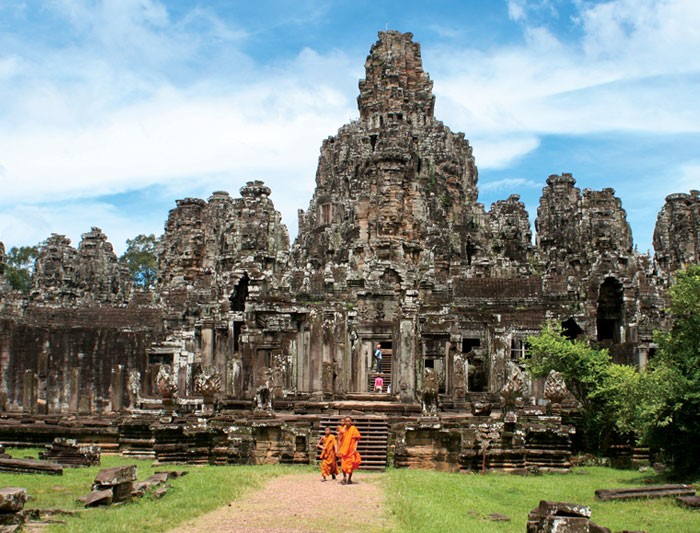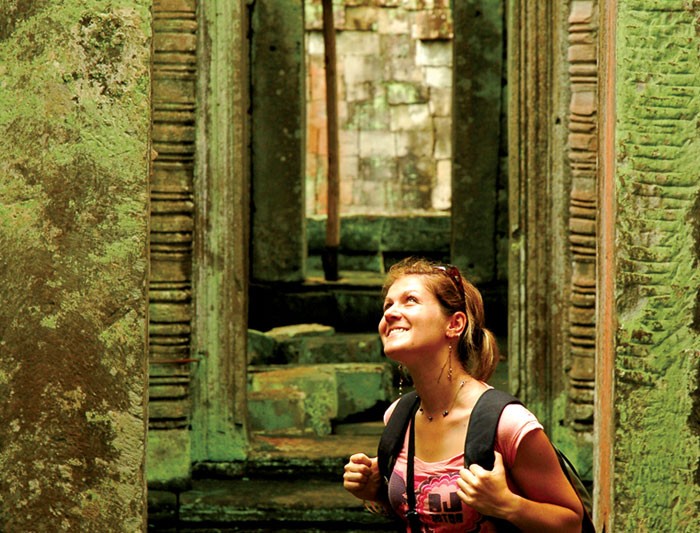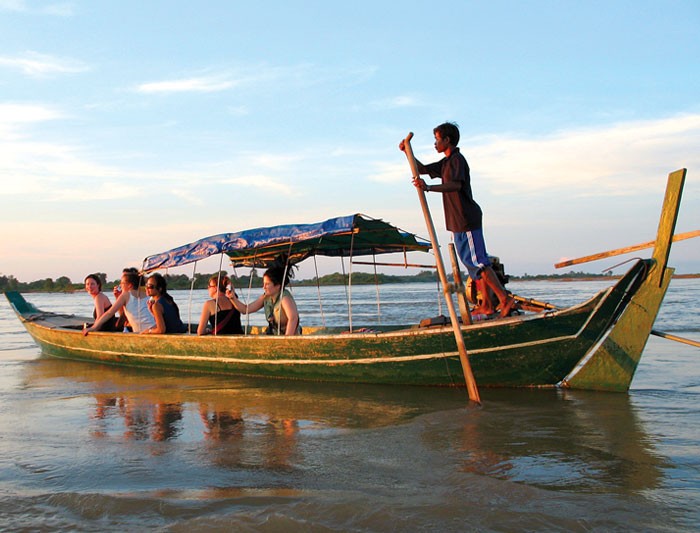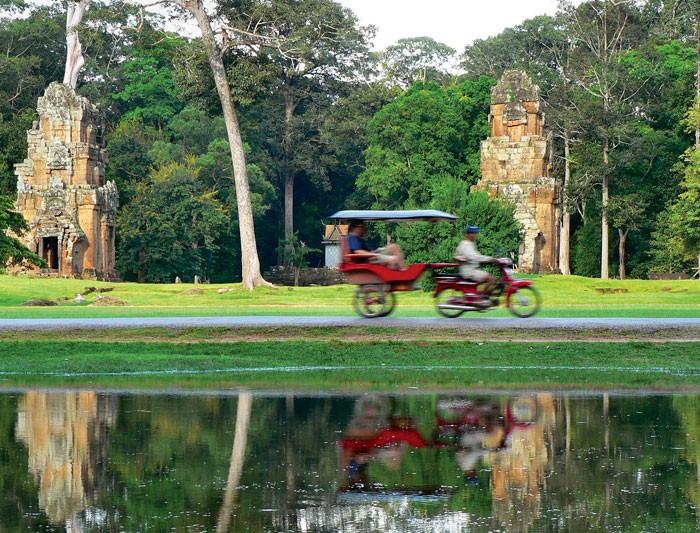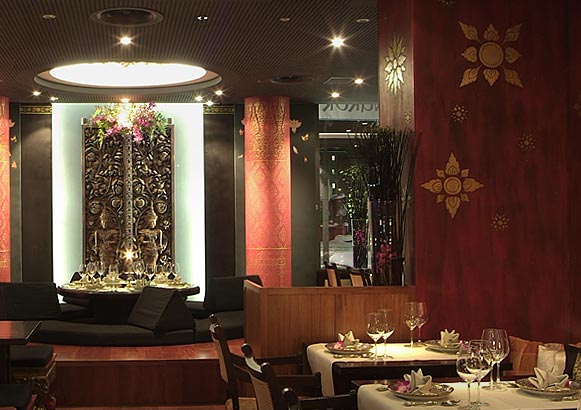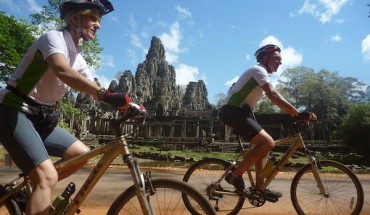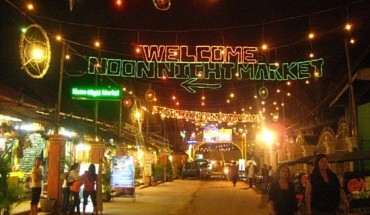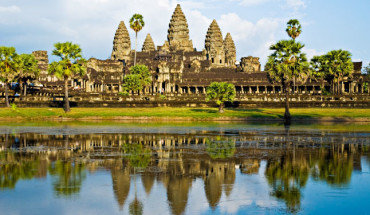Angkor Travel Information
Most visitors to Angkor arrive by air as the large number of international and domestic carriers servicing the country make flying a comfortable and viable option. Local as well as long-distance buses from Vietnam and Thailand provide an affordable alternative. However, though the highway from Phnom Penh has improved, the poor condition of most roads can result in delays and much discomfort in reaching Siem Reap. A more scenic approach is by ferry or boat. Regular hydrofoil services link Siem Reap with Phnom Penh, as well as Siem Reap and Chau Doc in Vietnam. Moving around within Angkor is easy, with several inexpensive modes of transport to choose from.
When To Go
The best time to visit Angkor is during the country’s cool season, between November and February, although it can still be rather warm for most tourists. Alternatively, during the rainy season between June and November, Angkor is green and relatively cool if rather wet. At this time, the barays (reservoirs) and certain temples such as Preah Neak Pean overflow with water. It is best to stay away during the hot season between March and May, when temperatures in Angkor can escalate to boiling point.
Getting There
There are two international airports in Cambodia Phnom Penh International Airport and Siem Reap International Airport. With several national and international airlines offering flights to both Phnom Penh and Siem Reap, visitors will find getting to Angkor easy Major international airlines include Vietnam Lao Airlines, Airlines, Malaysia Airlines, SilkAir, Thai Airways, Bangkok Airways, and China Southern Airlines. Except for the last two, all these airlines operate direct flights to Siem Reap from popular holiday destinations such as Hanoi, Ho Chi Minh City, Kuala Lumpur, Bangkok and Singapore. To facilitate national travel there are couple of domestic carriers that fly from Phnom Penh to Siem Reap on a daily basis-siem Reap Airways and Air Asia. Note that it is not uncommon for flight schedules to change suddenly or even for local airlines to shut down completely. For up-to-date information on air fares, routes, and flight timings check with your travel agent. With the recent opening of border crossings for foreigners wishing to enter Cambodia from Thailand and Vietnam, traveling by bus or taxi is now a feasible and cheaper option. Visitors entering from Vietnam have the choice of crossing over from Moc Bai to Bavet or from Chau Doc to Phnom Penh. Several scheduled buses run from Ho Chi Minh City to Phnom Penh. This seven hour journey costs about US$6. From Phnom Penh, you can take a shared taxi or minibus to Siem Reap on a five-hour trip.
Another mode of traveling to Angkor is by ferry or boat. The river border crossing between Cambodia and Vietnam lies on the Mekong River. Boats run from Chau Doc to Phnom Penh at regular intervals; the journey takes three to four hours, with fares ranging from US$15 to US$35. Hydrofoils from Phnom Penh to Siem Reap run daily, and are easily available but the journey can take up to six hours. Boat tours also operate from Ho Chi Minh City to Siem Reap. These are, however, more expensive than the other cruises. Some of the well known agencies offering boat tours include Pandaw Cruises and Victoria Hotels.
Visas And Passports
Getting a visa for Cambodia is a relatively easy process. A one-month visa is issued on arrival not only at the Phnom Penh and Siem Reap International Airports, but at land and river border crossings as well the tourist visas are priced at U$20, and business visas at US$25, both payable in US dollars. A passport photograph is required. Visitors can extend their stay by applying for an extension in Phnom Penh. Those who overstay their visa are fined US$5 each day.
Tours From Vietnam
There are several reputed travel agencies in both Hanoi and Ho Chi Minh City that arrange tours from Vietnam to Angkor although packaged tours are predetermined visitors can also draw up personalized itineraries. The prices are usually inclusive of travel costs, sightseeing, and a guide. Visas, departure tax, and entry tickets to Angkor are generally not included.
Getting Around
Transport in Siem Reap and Angkor is readily available, and comes in various forms, including bicycles, motors (motorbike taxis), minibuses, three-wheeled motorcycle taxis, and elephants. The fares for all can vary, ranging from US$1 to US$40 for a few hours to an entire day. A great way to explore Angkor is on a bicycle, available to rent from bike shops and hotels. The most comfortable way to travel, however, is by hiring a car easily arranged through hotels in town. An air-conditioned car with driver costs around US$30 per day.
Customs Information
Customs procedures tend to be strict. The usual prohibitions on importing pornography and drugs apply. Signs warn against bringing explosives into the country, and you may need to declare at the customs if you carry above US$3,000 the most enforced custom regulation is the smuggling of antiquities dating from or before the Angkorian period.
Departure Tax
For international flights there is a departure tax of US$25 per person. This is, strangely, more expensive than an entry visa. The departure tax for domestic flights is US$6. Both are payable in US dollars.
Angkor Practical Information
After years of much unrest, Cambodia is presently undergoing a phase of economic recovery and reinvention. An important part of this process is its tourism industry, which is currently experiencing a major boom. The credit for this is largely due to the rich cultural heritage of Angkor, and the millions of visitors it each year attracts As a result, the sleepy town of Siem Reap, serving as a gateway to Angkor, has transformed into a bustling tourist town, with lodgings to suit all pockets, as well as several eateries. The single ticket system, easily arranged transport, and new communication facilities, have made sightseeing in Angkor straightforward.
Admission Charges And Opening Hours
To gain access to the huge Angkor complex, all visitors need to purchase a pass from the admission booth located at Angkor’s main entrance, open from 5am-6pm every day. The ticketing system in effect here might seem a bit expensive at first glance but offers good value for money, especially because part of the funds collected go towards the preservation of Angkor’s many historic monuments.
Three types of passes are available, each allowing entry into all the monuments in the complex. Choices range from a one-day pass for US$20, ideal for a quick walk through the main ruins a three-day pass for US$40, sufficient for exploring the prominent temples, and a one-week pass for US$60 which allows ample time for visiting all the sights. A passport-size photograph has to be provided along with the entry fee to create an identity pass. You can carry your own picture or have one taken at the admission booth, though this might take time. This pass must be shown at each site.
Tourist Information
The privately-owned Tourism Information Office in Siem Reap is housed in a white building on Pokambor Avenue, but is not particularly helpful except for making bookings. More useful, and in the same building, is the Khmer Angkor Tour Guide Association, which along with for rent, offers cars licensed and well informed, English-speaking drivers The quarterly publication Siem Reap Angkor Visitors Guide provides up-to-date travel-related information to visitors. It includes shopping and transport listings, as well as a detailed list of restaurants and hotels in the area. It is available free of charge at many hotels all over town.
Where To Stay
At one time, accommodation in Siem Reap was scarce and unappealing, but today, new hotels and guesthouses seem to be opening every month. The variety of lodgings available is wide, with options to suit different budgets. From five-star luxury hotels such as Grand Hotel d’Angkor to a range of family-run hotels with basic conveniences and a selection of well-equip ped and very reasonably priced guesthouses Visitors who have not opted for a pre-booked tour will find plenty of information regarding accommodation at the airport. Many touts also hover around the airport but it is wise to exercise caution when dealing with them scam artists are not rare. Most establishments, even down to the humblest guesthouses, will send a car and driver to meet you at the airport. Another easier and often substantially cheaper option is to book online. Note that room rates usually fluctuate between expensive during peak season from November to March, to very cheap during the low season from May to November.
Where To Eat
The assortment and quality of cuisines available in Siem Reap is varied enough to suit all tastes, ranging from Thai, Cambodian, Vietnamese, and Chinese to French, Indian, and even Italian. The array of eateries to choose from is also impressive. There are a number of reasonably priced restaurants, especially near Psar Chaa. This area is packed with street food vendors many serving local fare. Baguettes, pate, and good coffee can be found on almost every corner. Most guesthouses have small cafés, while the larger hotels boast fine restaurants. Some are willing to pack picnic baskets as well if requested.
Personal Health And Security
Cambodia is a poor country, and not particularly advanced in health care. In almost any serious situation, it makes sense to be evacuated for treatment to nearby Bangkok. However with proper pre- cautions it should be possible to leave Cambodia with no health problems at all. Drink only bottled water, eat well-cooked food, avoid ice, and be sure to wash your hands before eating. To avoid dehy duration, heat exhaustion, and even heatstroke when visiting Angkor, carry bottled mineral water and wear a hat or headscarf Avoid going out during the hottest part of the day. Malaria is present in parts of Cambodia, including Angkor and travelers can take a prophylactic. Other risks are hepatitis and rabies. Ask your doctor about immunization requirements before you travel. STDs and AIDS are also prevalent in Cambodia. Unexploded mines are a serious concern in Siem Reap. Tourists should steer clear of areas off the well-beaten path, and stay close to their guides. Personal security in Angkor can be taken care of apply buying common sense. Avoid dark and remote areas, do not wear too much jewelry or revealing clothes in the case of women, and leave valuable items in the hotel safe. Tourist police and guards are stationed at points throughout the complex.
Banking And Currency
The Cambodian currency is the riel. Visitors to Angkor rarely need to use the riel as for all tour its transactions, the US dollar is the preferred currency, and failing this, the Thai baht is acceptable. Still, it is a good idea to keep some change in riel handy for giving small tips or buying very cheap items. There are several banks in Siem Reap, offering facilities for exchanging currency and cashing traveler’s checks. Banking hours are generally from Monday to Friday, 9am 4pm. Although cash remains essential, major credit cards are widely accepted, and can be used to obtain a cash advance from a bank. ATMs, courtesy of ANZ Royal Bank, are another source of cash.
Communications
The communication network in Angkor is fairly well developed. Making international calls is simple, using either prepaid calling cards for public telephones, or Internet phone services, available in most cyber cafés. It is also possible to call from your hotel, but this is a more expensive option. The area code for Siem Reap is 063.
Internet cafés are plentiful and affordable, and there are no government restrictions or limits Internet access. For on postal and courier services, visitors can head to the main post office in town, or agencies such DHL and FedEx.
Disabled Travellers
There are presently virtually no special facilities for disabled travelers anywhere in Angkor. Many of the new luxury hotels however, are making effort and to become better equipped to meet the needs of those who require special assistance.


